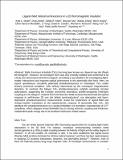| dc.contributor.author | Seyler, Kyle L. | |
| dc.contributor.author | Zhong, Ding | |
| dc.contributor.author | Klein, Dahlia Rivka | |
| dc.contributor.author | Gao, Shiyuan | |
| dc.contributor.author | Zhang, Xiaoou | |
| dc.contributor.author | Huang, Bevin | |
| dc.contributor.author | Navarro Moratalla, Efren Adolfo | |
| dc.contributor.author | Yang, Li | |
| dc.contributor.author | Cobden, David H. | |
| dc.contributor.author | McGuire, Michael A. | |
| dc.contributor.author | Yao, Wang | |
| dc.contributor.author | Xiao, Di | |
| dc.contributor.author | Xu, Xiaodong | |
| dc.contributor.author | Jarillo-Herrero, Pablo | |
| dc.date.accessioned | 2019-06-21T16:38:13Z | |
| dc.date.available | 2019-06-21T16:38:13Z | |
| dc.date.issued | 2017-12 | |
| dc.date.submitted | 2017-06 | |
| dc.identifier.issn | 1745-2473 | |
| dc.identifier.issn | 1745-2481 | |
| dc.identifier.uri | https://hdl.handle.net/1721.1/121374 | |
| dc.description.abstract | Bulk chromium tri-iodide (CrI₃) has long been known as a layered van der Waals ferromagnet. However, its monolayer form was only recently isolated and confirmed to be a truly two-dimensional (2D) ferromagnet, providing a new platform for investigating light-matter interactions and magneto-optical phenomena in the atomically thin limit. Here, we report spontaneous circularly polarized photoluminescence in monolayer CrI₃ under linearly polarized excitation, with helicity determined by the monolayer magnetization direction. In contrast, the bilayer CrI₃ photoluminescence exhibits vanishing circular polarization, supporting the recently uncovered anomalous antiferromagnetic interlayer coupling in Crl₃ bilayers. Distinct from the Wannier-Mott excitons that dominate the optical response in well-known 2D van der Waals semiconductors , our absorption and layer-dependent photoluminescence measurements reveal the importance of ligand-field and charge-transfer transitions to the optoelectronic response of atomically thin CrI₃. We attribute the photoluminescence to a parity-forbidden d-d transition characteristic of Cr³⁺ complexes, which displays broad linewidth due to strong vibronic coupling and thickness-independent peak energy due to its localized molecular orbital nature. | en_US |
| dc.description.sponsorship | National Science Foundation (U.S.) (Grant DMR-1231319) | en_US |
| dc.description.sponsorship | Gordon and Betty Moore Foundation (Grant GBMF4541) | en_US |
| dc.publisher | Springer Nature | en_US |
| dc.relation.isversionof | http://dx.doi.org/10.1038/s41567-017-0006-7 | en_US |
| dc.rights | Article is made available in accordance with the publisher's policy and may be subject to US copyright law. Please refer to the publisher's site for terms of use. | en_US |
| dc.source | arXiv | en_US |
| dc.title | Ligand-field helical luminescence in a 2D ferromagnetic insulator | en_US |
| dc.type | Article | en_US |
| dc.identifier.citation | Seyler, Kyle L. et al. “Ligand-Field Helical Luminescence in a 2D Ferromagnetic Insulator.” Nature Physics 14, 3 (December 2017): 277–281 © 2017 The Author(s) | en_US |
| dc.contributor.department | Massachusetts Institute of Technology. Department of Physics | en_US |
| dc.contributor.department | MIT Materials Research Laboratory | en_US |
| dc.relation.journal | Nature Physics | en_US |
| dc.eprint.version | Author's final manuscript | en_US |
| dc.type.uri | http://purl.org/eprint/type/JournalArticle | en_US |
| eprint.status | http://purl.org/eprint/status/PeerReviewed | en_US |
| dc.date.updated | 2019-03-27T13:19:48Z | |
| dspace.orderedauthors | Seyler, Kyle L.; Zhong, Ding; Klein, Dahlia R.; Gao, Shiyuan; Zhang, Xiaoou; Huang, Bevin; Navarro-Moratalla, Efrén; Yang, Li; Cobden, David H.; McGuire, Michael A.; Yao, Wang; Xiao, Di; Jarillo-Herrero, Pablo; Xu, Xiaodong | en_US |
| dspace.embargo.terms | N | en_US |
| dspace.date.submission | 2019-04-04T12:00:06Z | |
| mit.journal.volume | 14 | en_US |
| mit.journal.issue | 3 | en_US |
| mit.license | PUBLISHER_POLICY | en_US |
